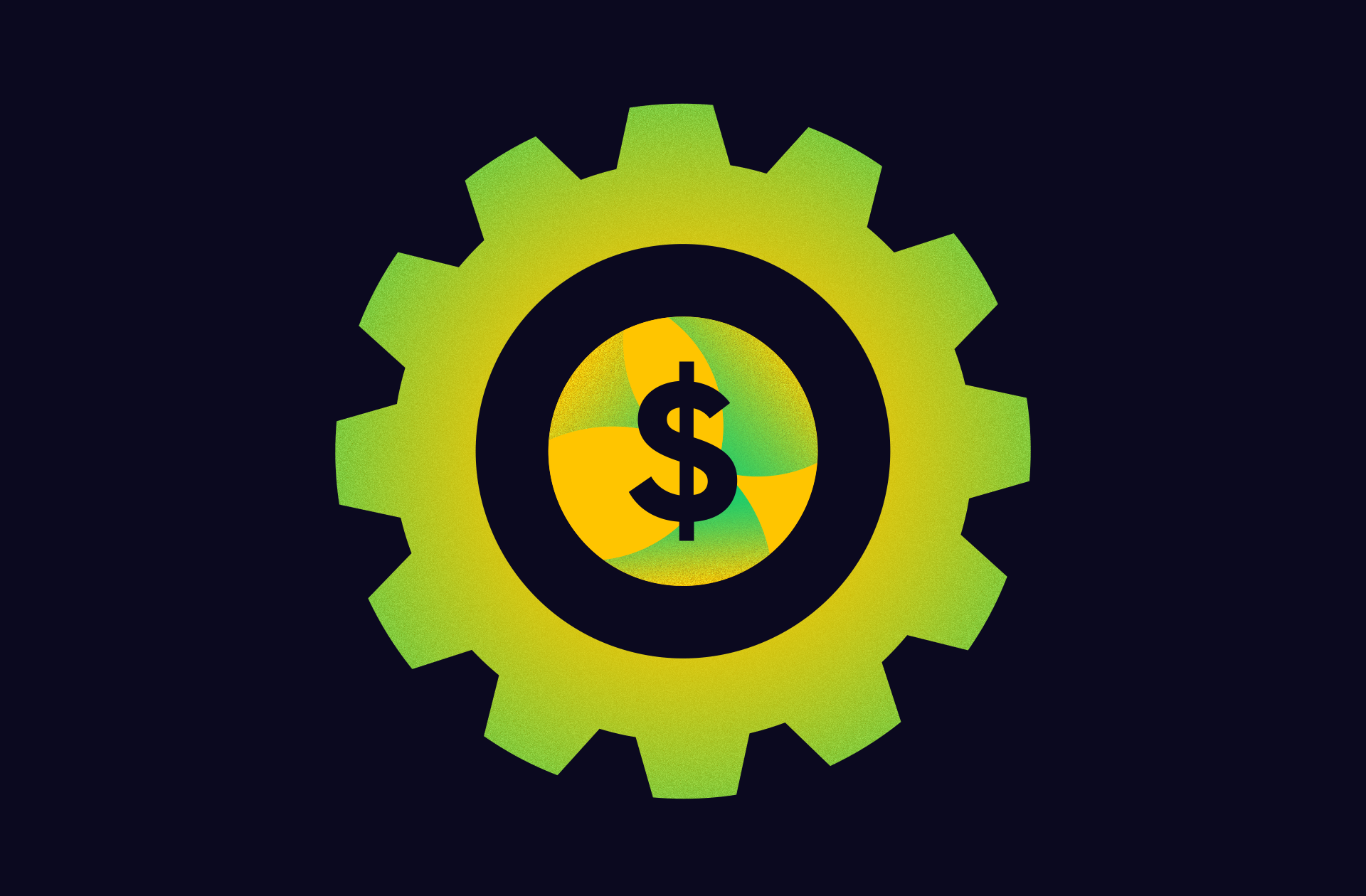Do you remember that one time you had a meeting where everyone was prepared, knew the objective of the meeting, and truly valued one another’s unique contributions? Sure, these meetings happen—about as frequently as Halley’s Comet. Assuming that you work with good people who care, why is it so hard to create the right conditions for fruitful creative collaboration? Often, it’s because you have insight into the project, but not each other. Different creative types work differently, and it’s only by understanding both yourself and your colleagues that you can get to the root of the challenge. Here, we’ll dive into the different creative types, their strengths, and the different ways you can use their powers to boost your team’s success.
HOW CREATIVE TYPES THINK
Your team’s success relies on the individual psychology of your team members: how much each of you slept, how things are going on the homefront, whether you drank too much or too little coffee, and the specific world you work in each day.

The best you can hope for is perfection in imperfection, but how can you get to a place where you’re all fulfilled in your creative work, respecting individual contributions and getting work completed? (As a cofounder of Column Five, this has been my biggest challenge.)
Rather than the previous assumptions about left-brained and right-brained people, neuroscientists now believe that each creative choice involves complex circuitry across both sides of the brain, as well as combinations of processing modes (spontaneous and/or deliberate) and information structures (emotional and/or analytical). These factors shape how your team members work individually and with others.



While individuals are not entirely deliberate, spontaneous, emotional, or analytical (or any single combination), it’s important to understand where each teammate lands on the quadrant, without judgment about which type is best/worst. Don’t look down on someone who is emotional as lacking logic, or think of someone who is analytical as being bureaucratic. Each has a unique power.
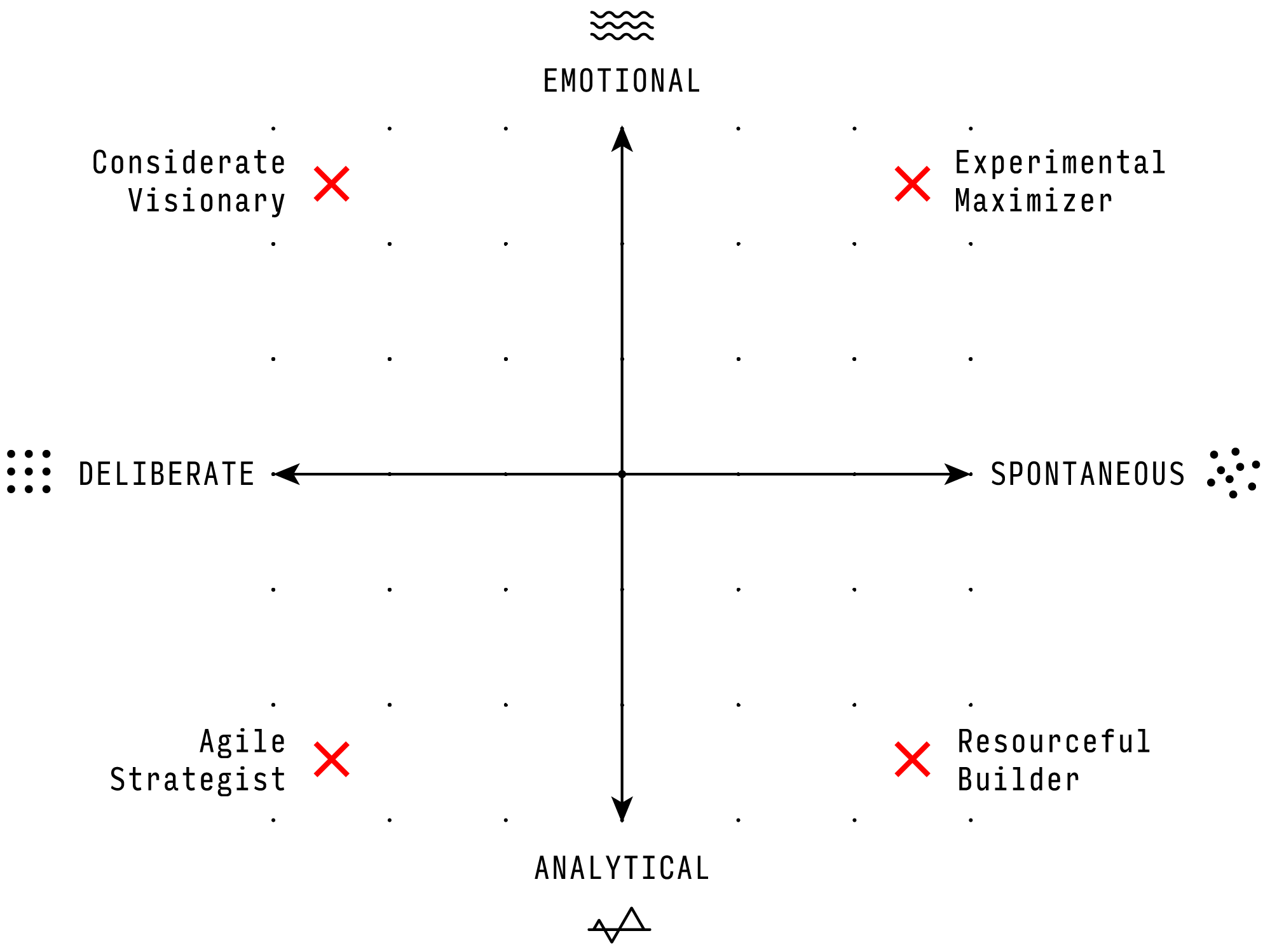
Once you understand what dynamics are at play, you can coordinate more effective meetings by building smart bridges between the processing types on your team.
THE 3 KEYS TO SUCCESSFUL COLLABORATION
The creative process is messy within an individual brain, and it’s made even more complex when you add a bunch of creative types (and egos) in one room. When looking to optimize your team’s creative collaboration, be aware of the three key variables that influence all important creative choices to be made as a team.
- Time horizon: Are you planning for next week, next year, or the rest of eternity? Before you dive into ideation, everyone should understand the time horizon you’re talking about. Make sure everyone is on the same page.
- Level of detail: Are you talking about high-level ideas or a 17-point action plan? One of my colleagues often tells me to zoom in and then later to zoom out within a single conversation, which can be frustrating and derailing. Hence, establishing zoom level at the beginning of the conversation is important.
- Type of processing: The best chance at the best idea comes from having a well-curated team with a variety of skills needed to solve the problem at hand. Understanding how your teammates process information and make creative choices is the key to curating this mix and collaborating successfully.
THE 4 CREATIVE TYPES
However, to truly understand the creative types you’re working with (and which type you are), you need a deeper understanding of the unique strengths and traits of the four creative types:
- Considerate Visionary
- Agile Strategist
- Experimental Maximizer
- Resourceful Builder
Let’s take a deep dive into the strengths and challenges of each and how to work most effectively with them.
1. CONSIDERATE VISIONARY (DELIBERATE/EMOTIONAL)

The Considerate Visionary (CV) cares a lot about the future and sees loose connections between ideas. If you’ve sat through more than a few meetings with this person, you might feel like the CV completely derailed the group.
It’s a challenging balance. As a team, you need to allow room for spontaneous ideation and improvement of the current course. However, you also need to get things done. If you spend all your time imagining, nothing will get built and tested.
So, the best way a CV can be a team player is to be considerate. Rather than coming in like a bull in a china shop and assuming no one else has thought about the future, this person can help improve team dynamics by asking questions before making assertions.
This simple tweak, to ask a question and truly listen, has helped me a lot with our team. I generally thrive in this mode of creativity, and I used to come in pretty hot (as more of an Inconsiderate Visionary) after reading a few articles and declare that we were moving too slowly or not focusing on big enough challenges.
Unsurprisingly, this alienated me from the other smart people on the team at times. It’s easy to see why this didn’t work in retrospect; no one likes it when someone comes over, opens the hood, and starts critiquing work without taking time to gather context.
PROS:
- Thrives in pursuit of the unknown/leap of faith.
- Stays attuned how the world is evolving.
- Connects the dots between their ideas and the thought processes of the larger team.
TIME HORIZON:
A CV generally trusts the team with the near-future execution and strives to anticipate where the world is headed over the next year and beyond.
CHALLENGES:
The CV’s pursuit of the unknown and belief in something impossible can be maddening to a team that wants better blueprints. Even with an accurate crystal ball (which the CV admittedly doesn’t have), the way the world might look in 3 years doesn’t necessarily help the business do what it needs to do today.
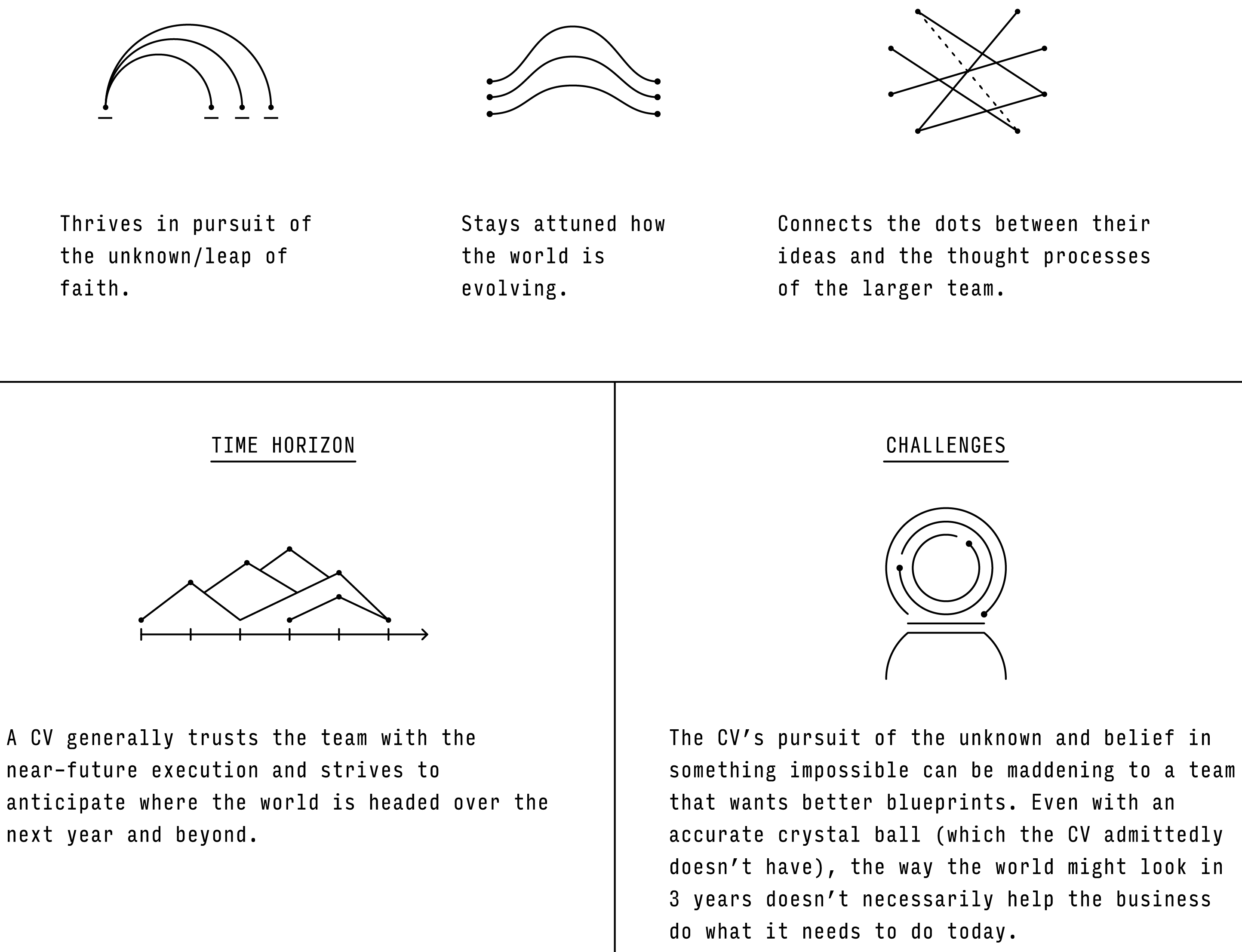
HOW TO COMMUNICATE WITH A CONSIDERATE VISIONARY:
Work together to keep conversations grounded in the present without discouraging bigger-picture thinking. We created a Slack channel called “Big Ideas” for anyone to safely post ideas for 6-12+ months down the road.
Context is crucial (again, framing the level of detail and time horizon for consideration at the beginning of the meeting helps everyone stay in the same space/time coordinates). Is this a meeting to discuss what the team is doing this week? The CV needs to respect the time and preparation that went into mapping out these near-term tasks. Is this a casual walk-and-talk about what’s possible in the future with one other person? Let the weird ideas fly.
2. AGILE STRATEGIST (DELIBERATE/ANALYTICAL)
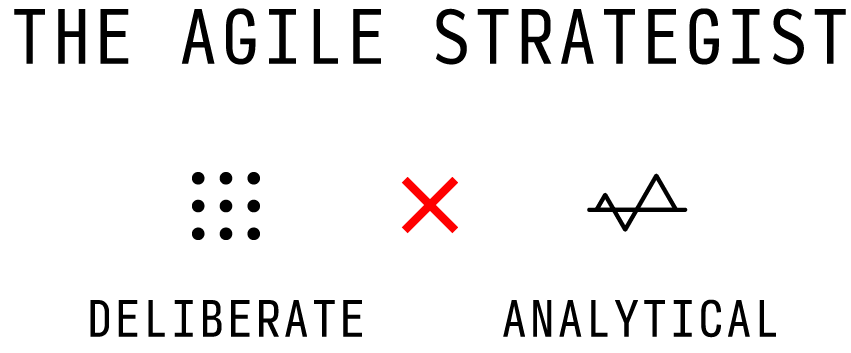
The Agile Strategist (AS) can be mistaken for a pessimist because of their one-track focus on identifying problems. It’s tempting to want to avoid this critical thinker at the early stages of ideas so that you can nurture an idea to life before smashing it to pieces. However, that’s a mistake.
If you are, say, a Considerate Visionary, and can separate critical feedback on an idea from an attack on who you are, then it can be really powerful to bring an AS into the earliest stage of an idea.
An AS thrives when they have room to critique without being labeled as a Gloomy Gus. If you’re not this person, try to empathize and imagine how you might feel if one of your greatest strengths and your natural creative process was consistently labeled as negative. That dynamic can spiral, in fact, and I’ve seen it.
You have a strong critical thinker who is dismissed as pessimistic, and then the next time around, you don’t loop that person into the early stages of the creative process. When the AS is eventually looped in as a key stakeholder, they still see the missing pieces and holes in the execution. The problem is now they must give that feedback at a later stage when changes are more costly.
This can lead to major tension in the creative relationship. At worst, it causes a complete breakdown and people leave the company—all because a different type of creativity wasn’t embraced for its unique value to the team, labeled a negative trait instead of a gift.
PROS:
- Uncovers blind spots.
- Distills a challenge to its essence.
- Connects the big-picture vision and the near-term tactical needs.
- Sets key building blocks for the larger team to take action.
TIME HORIZON:
The AS is always looking at impending challenges: How is this approach going to complicate things for future users of the product? What does the next month look like in detail? They will also have a sequence of initiatives in mind for the next 6-12 months.
CHALLENGES:
An AS must ensure they are not coming from a place of ego and belief that their way of doing things is superior. The important thing to focus on is the solution itself, honoring the value and work it has taken the team to get to this point.
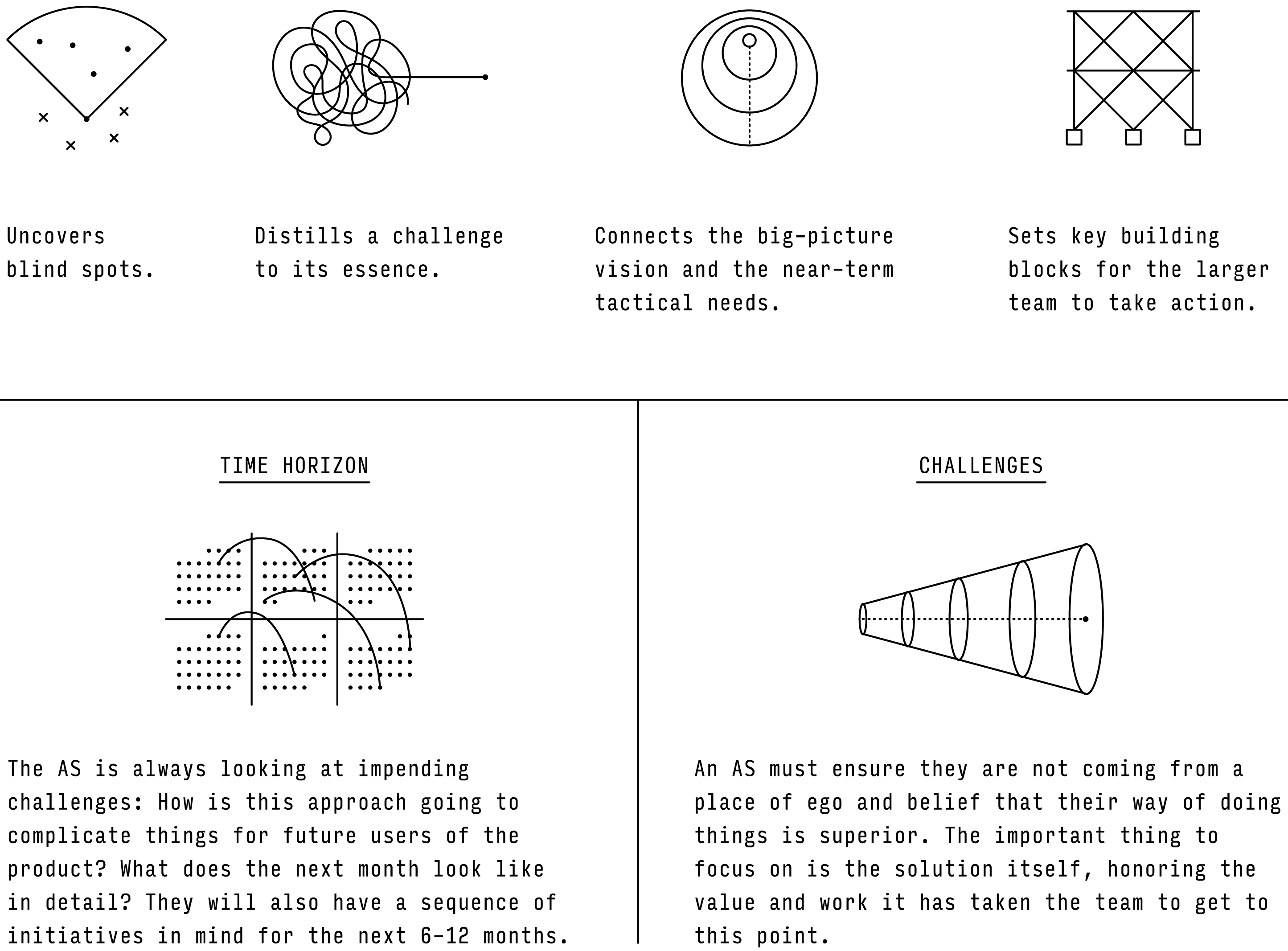
HOW TO COMMUNICATE WITH AN AGILE STRATEGIST:
Assume a person who fits this creative type has positive intentions—even when you haven’t always experienced that before. In the process, value the critical thinking and questions the AS is throwing at you rather than getting defensive.
Anticipate their critical thinking. You know it’s coming your way, so rather than coming in bright-eyed and bushy-tailed (or as a friend once labeled me, a prissy-ass optimist) only to get slaughtered by questions about the holes in your idea, be proactive by asking for feedback.
Present your seed of an idea, along with a request that demonstrates respect for strategic thinkers. Ask something like, “What questions do you need answered in order to get clarity on how/whether to proceed?” to mitigate the AS’ concerns.
Another thing that can help: Ensure there are clear, complete handoffs between team members. This ensures there are no loose ends or outstanding issues as the project moves to the next phase.
3. RESOURCEFUL BUILDER (SPONTANEOUS ANALYTICAL)
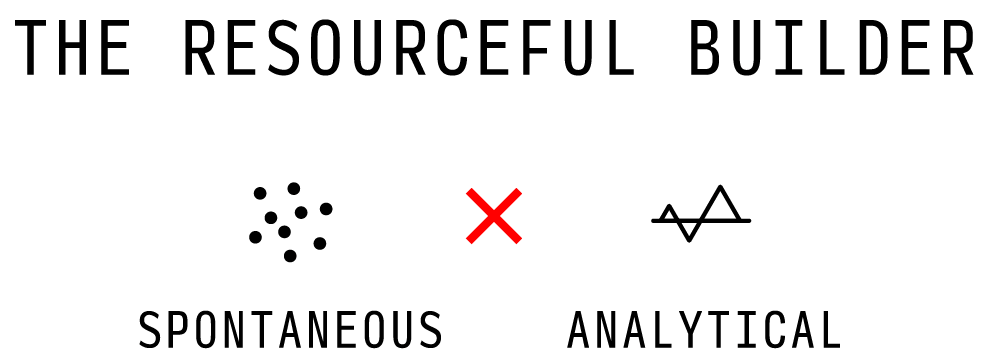
If you’ve ever found yourself saying, “I had that idea 4 years ago” or “I’ve been saying we should do this for years,” then you’ve likely suffered from a lack of Resourceful Builders on your team. A Resourceful Builder (RB) will critique any flaws in the logic of the plans and will experience tension (whether they express it immediately or not) if involved too late in the game to bring their (mostly) constructive criticism.
It’s one thing to go off on a leadership offsite and get super inspired about your plans for being the most loving people ever to pursue world domination. But aspirations dissolve into the ether without the right people to carry out the execution. RBs are fueled by a desire to see things through.
This isn’t about surrounding Creative Visionaries and Agile Strategists with Yes People who are afraid of criticizing a supposedly omniscient set of plans. It’s about getting things done enthusiastically. Even if a lot of the doers in your organization are relatively junior members of the team, including a strong RB in the early stage of the creative process early increases a sense of ownership of the final work product.
PROS:
- Refines details when provided with a strong plan foundation.
- Wants to get in the trenches and actually create and execute according to the blueprint.
- Makes critical judgment calls on the fly.
TIME HORIZON:
RBs are good at planning and scheduling the details of activities required for each day of the week. They want to plan a few weeks down the road but are often pulled into a reactive mode to put out fires and keep each day’s tactical activities in motion.
CHALLENGES:
Sometimes this person isn’t involved early enough in the process and can’t bring more creative firepower to the solution. In some cases, an RB takes on too much at once and starts to resent the tight deadlines, feeling like they aren’t afforded the time to do top-quality work. If you look at an RB as a worker bee rather than a creative individual, you’ll miss their full potential and reduce the amount of ownership and passion they feel for their work.
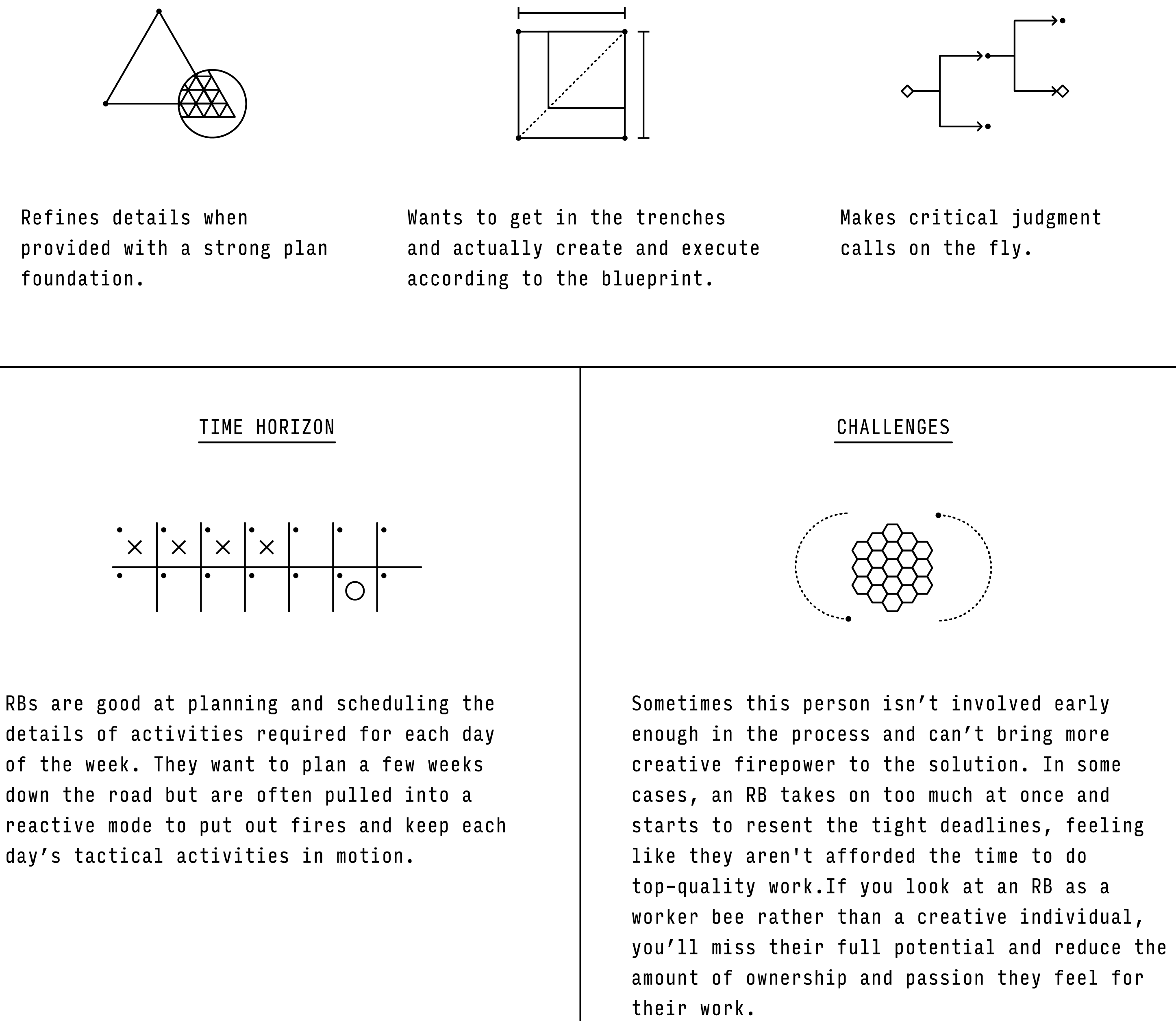
HOW TO WORK WITH A RESOURCEFUL BUILDER:
Rather than stifling an RB’s bigger ideas or criticism in the name of getting an issue resolved immediately, indulge in the RB’s active ownership and allow them to leverage their interest in digging deeper to ultimately find a more elegant solution to the problem.
4. EXPERIMENTAL MAXIMIZER (SPONTANEOUS/EMOTIONAL)

The Experimental Maximizer (EM) is, perhaps, the most rogue member of your team. This type of creative thinker likely drives the Resourceful Builders crazy on a weekly basis. But, when understood properly, the EM’s introduction of creative tension can be a source of originality and, though seemingly less structured than the Agile Strategist’s methodical arguments, is an important form of critical thinking about the way forward.
The courage to try something new without having all of the details figured out is necessary to take creative leaps as a group. When you allow this freedom, you just might pull an all-nighter or two, blackout in a blur of synesthesia, experience some brief infighting that leads to a healthy reconciliation and considerations of future processes, and wake up in innovative territory having accidentally uncovered a new line of business.
PROS:
- Loves to try new things.
- Comfortable with failing and learning.
- Good at connecting dots between loosely connected ideas.
TIME HORIZON:
An EM is a time traveler. Actions and ideas are spontaneous in the moment but correspond to gut feelings about how they will impact the organization for years to come.
CHALLENGE:
The EM’s experiments without hypotheses can lead to waste. Bringing in wild ideas late in the game can make other players on the team feel like their work up to that point is undervalued or disrespected.
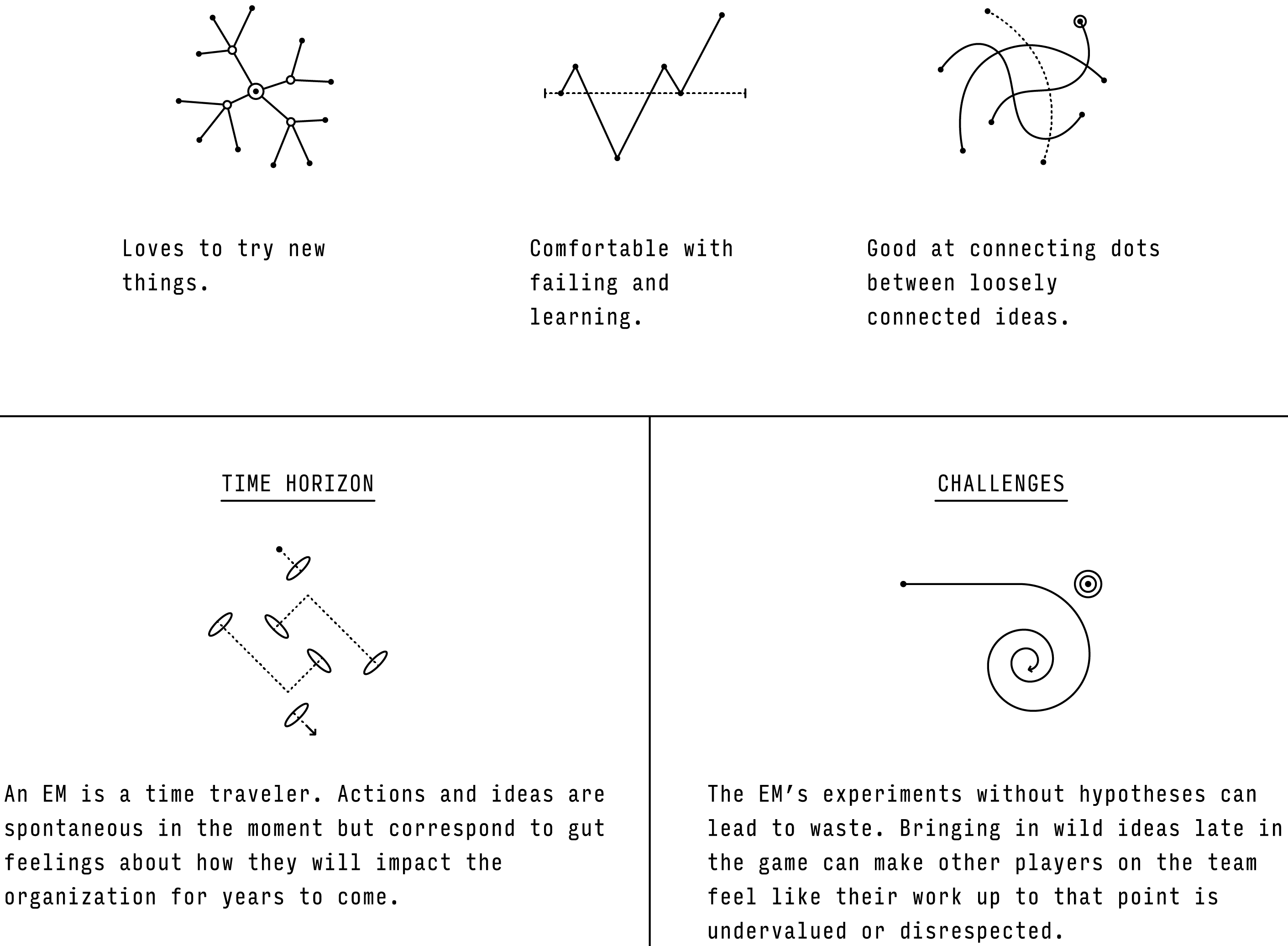
HOW TO WORK WITH AN EXPERIMENTAL MAXIMIZER:
Involve the EM in early discussions and make the creative objectives very clear. Focused priorities provide clean boundaries within which to run wild—without firing in random directions.
For example, if you are an Agile Strategist and have created a framework that distills several possible paths into a key question or choice to be made, you might run the paths and thinking by an EM.
Warning: If you don’t make the time horizon and overall focus clear, you could have a very tense discussion as the EM goes into free-thinking mode and starts firing off possibilities that are disruptive and deemed to be off-topic.
However, with the right boundaries in place and clearly stated objectives, the EM has the context and guidance to bring relevant yet still unconventional (and potentially radical and disruptive) ideas—without derailing the group.
HOW TO PUT THIS KNOWLEDGE INTO ACTION
All this theory is well and good, but what does it mean on a practical, day-to-day level? And, more importantly, how can you use this information to collaborate with your teammates and significantly boost your creative output?
These four steps will help you put a process in place for creative problem-solving and ideation that allows each creative type to be fulfilled. Each is framed as a meeting to help break down the challenge at hand and get each creative type’s input.
1. First Meeting: As you are thinking through a problem that requires many creative brains to solve, work together to generate a list of mutually exclusive, possible paths and ideas worthy of consideration. Ignore the urge to shoot these ideas the moment they are born, as the seemingly impossible ideas could later prove to be your path to survival as an organization. Keep them all alive for now.
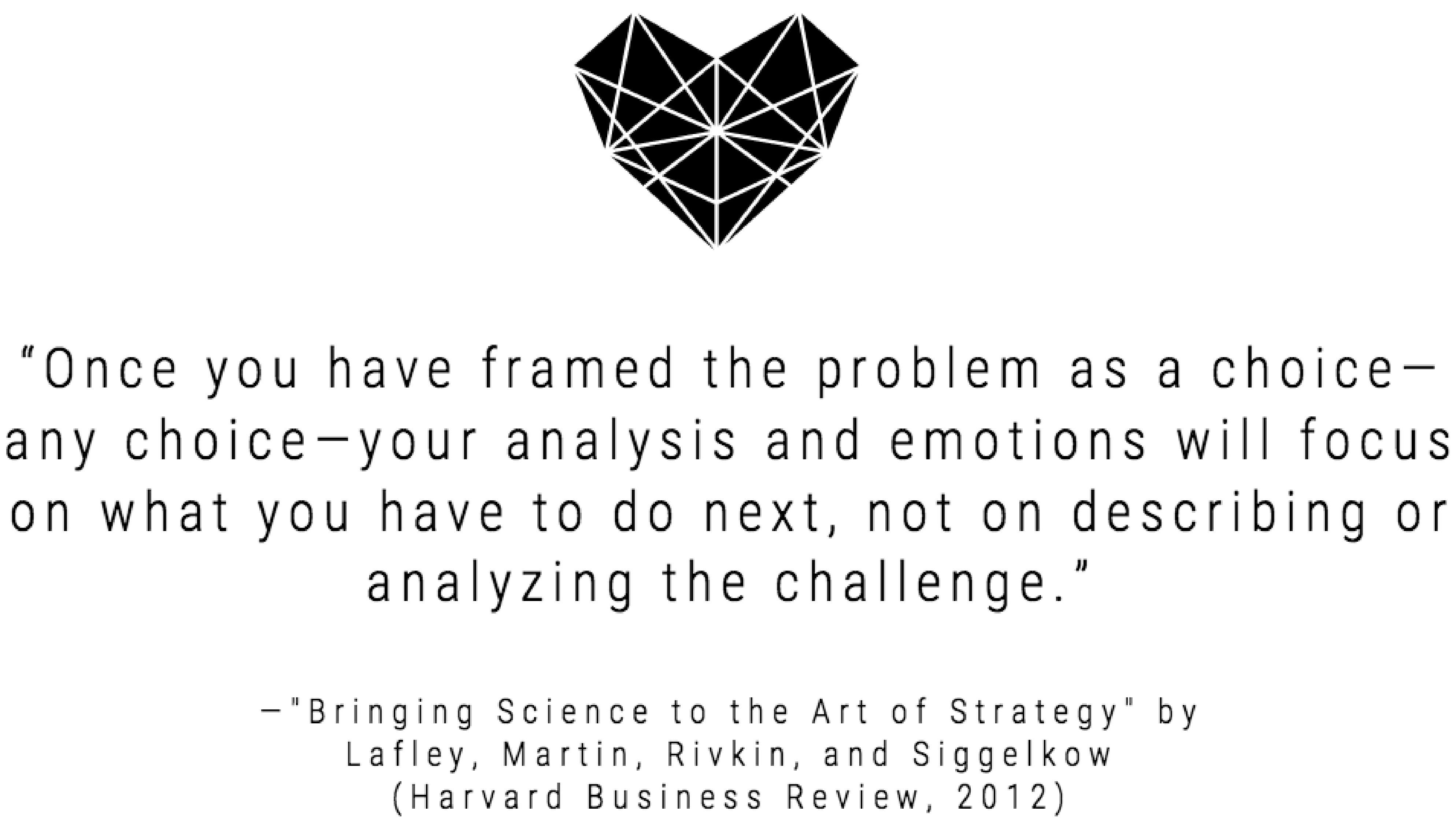
This initial approach creates a safe environment for the emotional/spontaneous Experimental Maximizers to get weird and experiment with wild ideas without necessarily having a 17-point plan in place for execution.
2. Second Meeting: Ask what conditions must hold true for each respective idea (or possibility) to succeed.
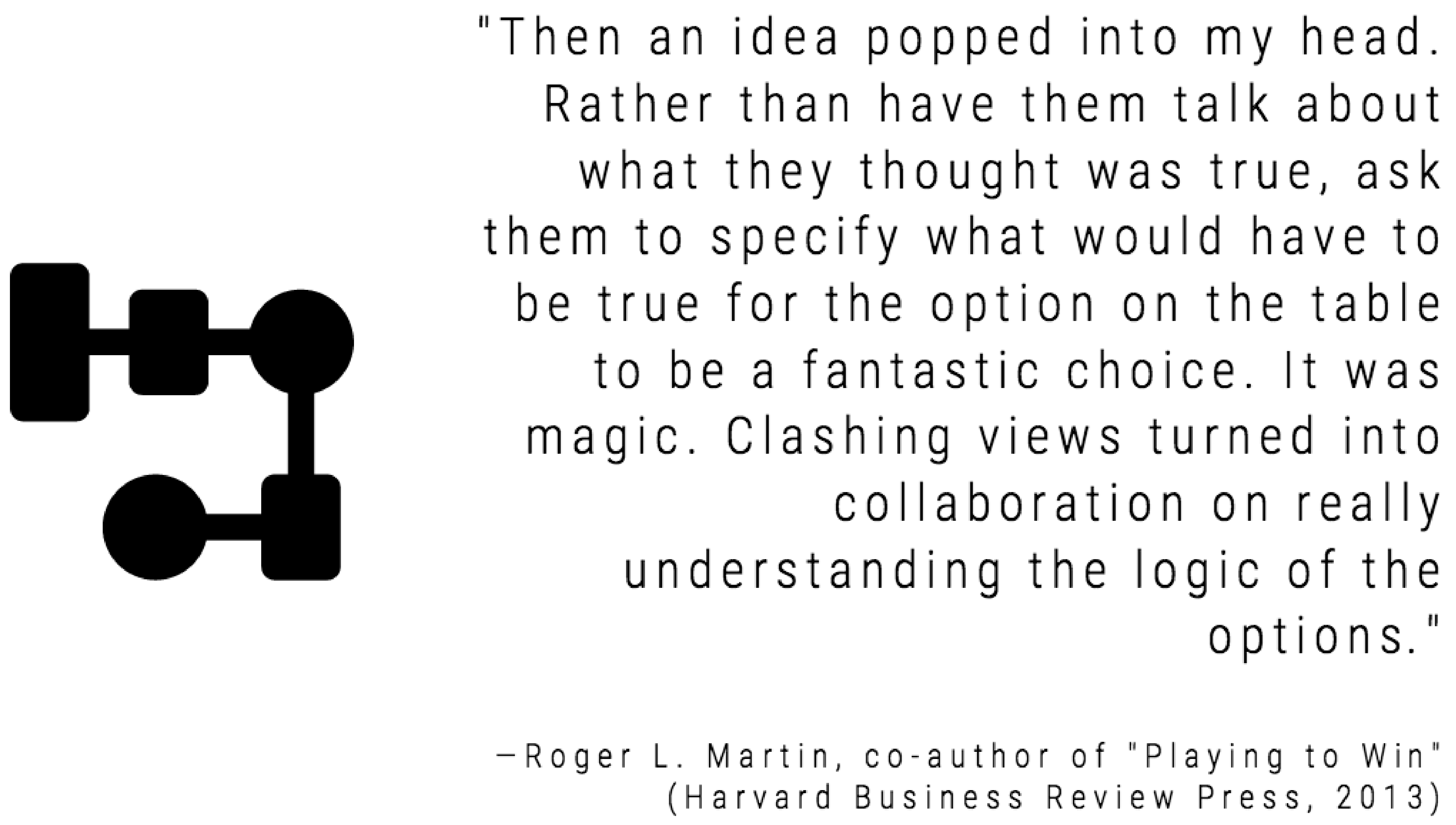
At this stage, you have some baby ideas that still need some nurturing. Don’t trample them yet. Perhaps one of you can be William Wallace and say “hold” every time someone is ready to go to battle against a “ridiculous” idea. Instead, by listing what would be required for each idea to succeed, you are still giving unconventional, bold ideas a fighting chance to be considered.
By getting the team to put together a complete list of what is required to bring an idea to life, you unlock the power of varied thinking and perspectives from the creative types.
This gives space for your critical-thinking Agile Strategists to convert the holes or flaws in the idea into a constructive statement by articulating it as a requirement (a condition that must hold true) for the idea to succeed (and get the buy-in of the Resourceful Builders who are so crucial as the winning ideas move towards execution).
3. Third Meeting: Think critically and test your options.

Soon enough, it’s time to start arguing. Yay! Our emotional/spontaneous Experimental Maximizers need to embrace the creative gifts of their deliberate/analytical Agile Strategist counterparts here by receiving the logic-based critique of each baby idea—not as a personal attack, but as their colleagues’ bringing their own creative superpower to the process.
This may require patience as fine details are debated, scientific tests are constructed, and processes are considered. Agile Strategists might even find some breathing room by breaking out into duos or trios to spec out and debate these specs so the “blue sky” folks (Considerate Visionaries) don’t get impatient and cause a communication breakdown. (And now I know why I was left off that calendar invite last week!)
4. Fourth Meeting: Make a choice.
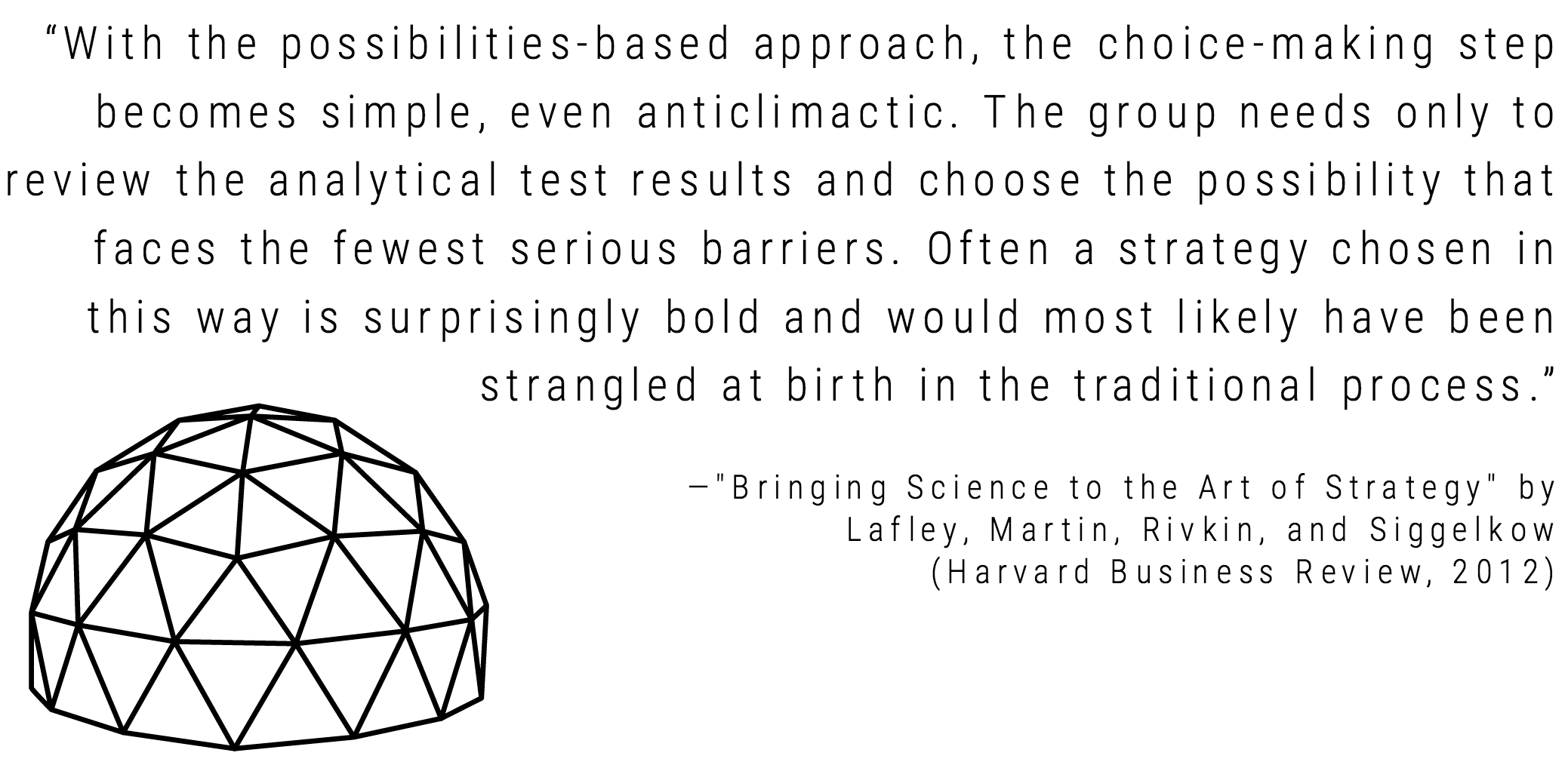
Now that we’ve asked the right questions and gathered data to test, we reach our aha moment. It’s important to establish the agenda ahead of this meeting, and let everyone know that the purpose of this meeting is to make a choice.
In fact, at one such meeting, one of my cofounders actually wrote on the whiteboard: “Now, we make a f$@%ing choice.” Never mind that we made the wrong choice that day and ended up going a different direction 6 months later. (But that’s a topic for a separate diary entry.)
Usually, because the group has had room to bring individual contributions that are truly valued in this framework, getting consensus on the path forward is smooth and, in some cases, truly a special and original path toward building an effective brand.
NOW, LET’S WRAP THIS UP
What do you need to remember?
- Embrace the mess; creative breakthroughs can be chaotic at times. Not that much is wrong with you.
- It’s normal to feel anxious, but know that it’s possible to cut through the clutter to find a positive creative path.
- It’ll never be a perfect process, but it can get easier to deal with when you understand—and use—the four types of creative people.
- When you legitimately value the other creative types on your team and their special brain powers (surprise!), they tend to value your contributions more frequently in return.
- The result: You’ll reduce the tension between colleagues and boost your creative output significantly.
Over to you now.
- What creative types do you have on your team?
- Does your team have a balanced blend of all four creative types?
- What time horizon is important to consider (the next month, year, or decade)?
BTW, don’t stop here. Learn what the latest research says about how introverts and extroverts exhibit creativity, find out how to gain creative confidence, and try this problem-solving exercise to tap into your team’s ideas.


